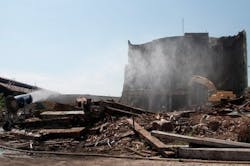Demolition Firm Conquers Dust on Ill. Remediation Project
IronHustler Excavating (IHX) is employing high-performance dust suppression technology in the remediation of the former Northwestern Steel & Wire riverfront facility in Sterling, Ill. The control measures prevent dust from becoming airborne and migrating from the site.
IHX and ELM Consulting teamed up to develop a demolition and environmental remediation plan for the 20-acre site of Plant 1, now being implemented in three phases. Phase 1 includes demolition and recycling of materials from the six buildings on the site, with IronHustler bringing down the buildings using excavators with grapple, shears and pulverizer attachments. ELM Consulting coordinated the project with IHX, providing soil boring, materials testing, inspections and monitoring to prevent the release of asbestos from rubble piles and deteriorating buildings. IronHustler uses the data to determine and verify contamination and ensure proper material handling.
The demolition and recycling process has the potential to generate large amounts of fugitive dust, so IronHustler effectively blankets the area with a DustBoss DB-60; this avoids complaints and possible health hazards with the most powerful of the suppression units offered by Dust Control Technology. Sterling city officials have noted the lack of nuisance dust from the site, and visiting EPA representatives have been impressed by the results.
An excavator outfitted with a hydraulic magnet, separating steel from the debris, sorts recyclable material from the rubble. All other recyclable materials—including wood timbers, lead sheets, plate and unprepared steel—will be sold for refining and recycling. IronHustler is using a RubbleMaster RM80 compact mobile impact crusher to break up the remaining brick and concrete, and all of the crushed material is re-used in preparation for the new development. Asbestos-containing materials, such as Transite pipe and other contaminants, are taken to an environmental landfill.
IronHustler president Dave Schielein began investigating alternative methods of dust suppression on demolition and recycling projects due to frustrations with the same dust management techniques that most firms try: manually spraying the area with a hose. “It was an expensive approach, having workers spend an entire shift spraying the site,” he observed.
“Even worse was the fact that it was so ineffective. The powerful spray would actually dislodge dust from the ground and send it airborne,” he said. “And the sheer volume of water quickly soaked the debris, turning it into a muddy mess. If we had to haul any material to a landfill after completing a job, we were actually paying extra for the water weight.”
Schielein did some research for an effective solution, comparing equipment from several manufacturers, ultimately specifying the DB-60 over other candidates. “No other manufacturer delivers the quality and durability of the DustBoss,” he commented. “Demolition job sites are tough on equipment, and we didn’t want to invest in a modified leaf blower that wouldn’t stand up to daily use.”
One of the things that impressed him was the technical acumen of the manufacturer. “Most people don’t realize that dust suppression is a technical issue,” Schielein said. “We liked the fact that DCT concentrates only on dust suppression, and they’re not concerned with selling a wide range of equipment. Dust management is all they do.”
The results were immediately apparent. “The effectiveness was the first thing we noticed,” Schielein continued. “The DB-60 covered a huge area with a very fine mist. Even the large oscillating models from competitors couldn’t match the coverage area.”
Then there’s the cost savings. IronHustler estimates that the company saves a net six hours of labor per day during demolition and recycling, allowing employees to concentrate on core activities and avoid potential worksite hazards. “The DustBoss started paying back from the first day we used it,” Schielein said. “It’s easy to operate and can run unattended all day.”
The Northwestern Steel and Wire plant, once owned by the Dillon family of Sterling, was founded in the late 1800s; it grew to employ almost 5,000 workers at the height of its success in the 1970s. The plant closed operations in 2001.
While the project is well underway, the city of Sterling has itself begun the nearly yearlong planning process for the land’s redevelopment. This side project aided in part by a $1 million interest-free loan to pay for the mitigation of asbestos at the site. The receipt of the 15-year loan was announced recently at a press conference held at the site. Pete Dillon, grandson of the mill’s founder and a former owner, was present to give a brief history of the company that once occupied the location.
“One has to have mixed feelings with the family history connected to this site,” he commented. “This was a great place…now, let’s see how we can plan for the next 100 years.”
Source: DustBoss

